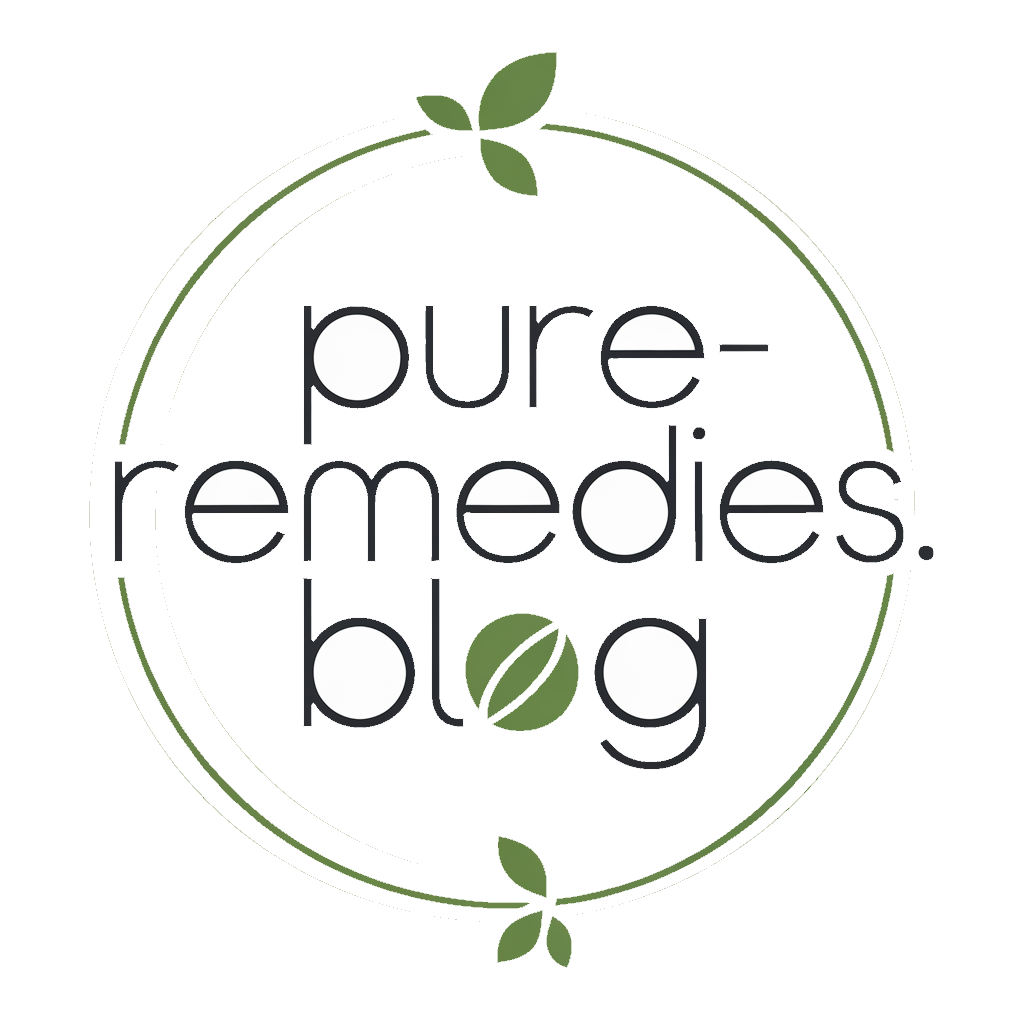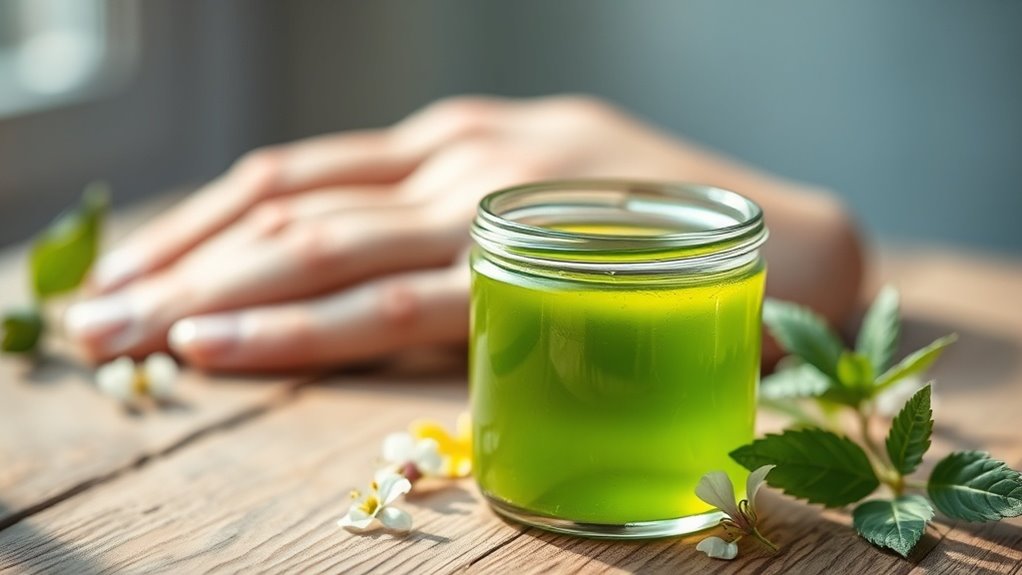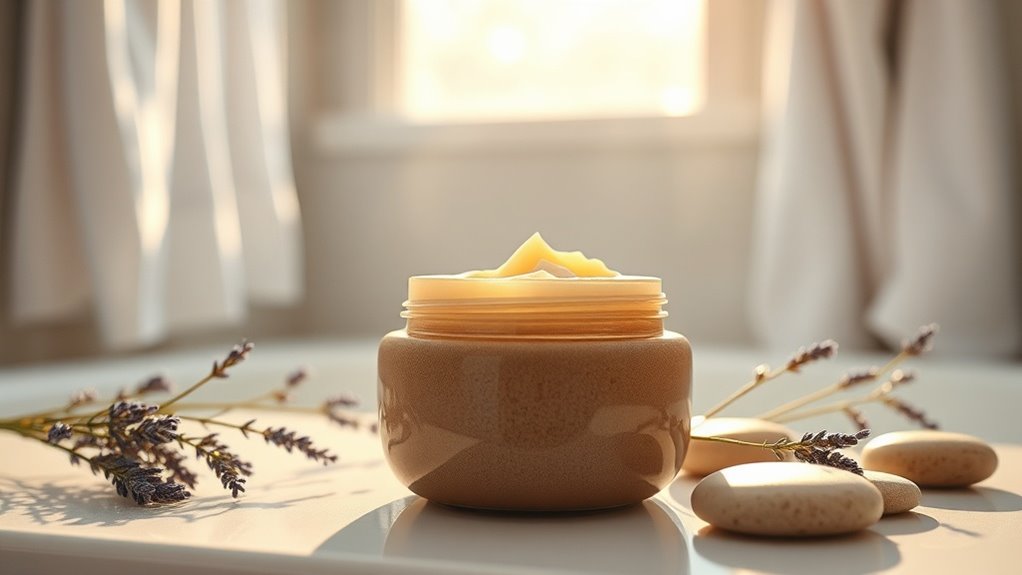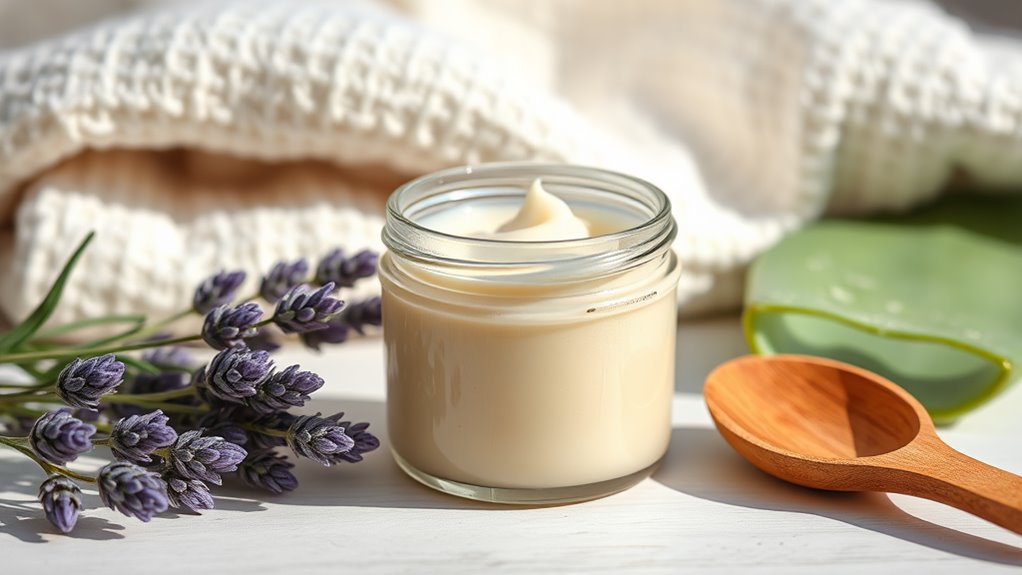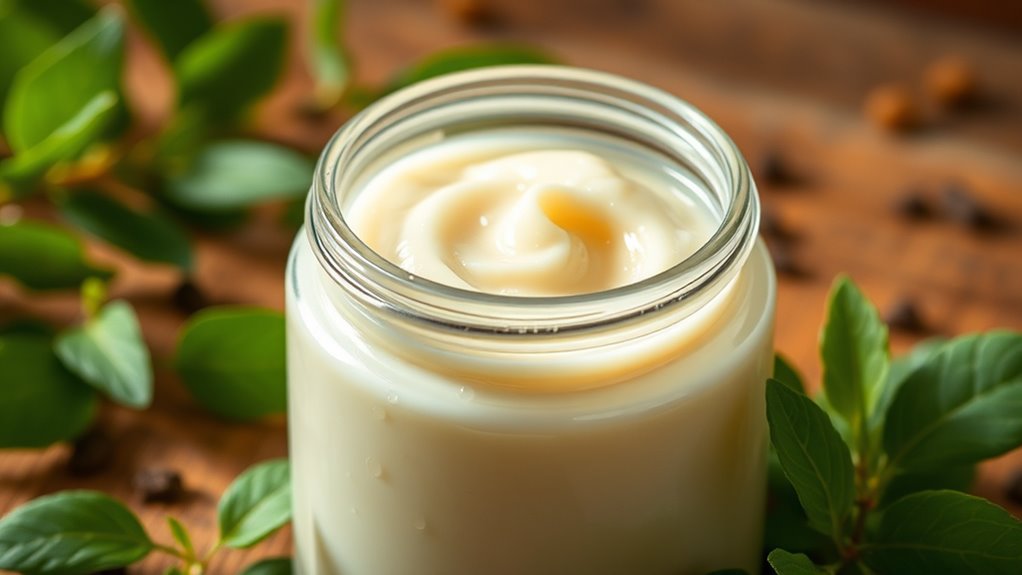Rashes Be Gone! Try This Skin-Soothing Herbal Bath Tonight
You can banish rashes tonight with a simple herbal bath featuring chamomile and calendula, which studies show reduce inflammation through compounds like apigenin and triterpenes. Add oatmeal for extra moisture and itch relief, creating a scientifically supported mix that promotes healing and soothes sensitive skin. It’s an effective, natural remedy you’ll love. Check out additional tips on customizing and combining herbs for even better results.
Key Takeaways
- Use chamomile and calendula in your bath to reduce rash inflammation and promote healing.
- Combine oatmeal and Epsom salt in warm water for moisture retention and detoxification.
- Always perform a patch test on your skin before trying new herbal ingredients.
- Soak for 15-20 minutes to soothe irritated skin without causing further dryness.
- Apply a ceramide-rich moisturizer after your bath to maintain the skin’s protective barrier.
Top Herbs for Soothing Rashes
When you’re dealing with skin rashes, herbs like aloe vera, chamomile, and calendula offer proven relief by reducing inflammation and promoting healing, as supported by clinical studies on their anti-inflammatory compounds.
You harness these as a natural rash remedy by understanding their mechanisms; for example, aloe vera’s polysaccharides form a protective barrier that enhances tissue repair, according to dermatological research.
Chamomile’s apigenin inhibits inflammatory pathways, minimizing itch and redness, as evidenced in randomized trials.
Calendula’s triterpenes promote collagen synthesis, speeding recovery, per peer-reviewed analyses.
Additionally, for stubborn eczema, a DIY home remedy using these herbs can provide effective relief when conventional treatments have failed.
Essential Ingredients for Your Bath
To create an effective skin-soothing herbal bath, you start by selecting soothing herbs like chamomile or calendula, which studies show reduce irritation.
Then, you choose essential oils such as lavender or tea tree, proven to alleviate inflammation through their antimicrobial effects.
Finally, you add key natural additives like oats or Epsom salts, which research indicates enhance moisture retention and skin barrier function. For enhanced relief, consider incorporating coconut oil, known for its anti-inflammatory properties.
Complement your bath routine with a eczema relief cream made from natural ingredients for prolonged relief.
Soothing Herbs Selection
Selecting the right soothing herbs for your bath involves choosing those with scientifically backed anti-inflammatory and calming properties, such as chamomile and lavender, which have been shown in studies to reduce skin irritation and promote relaxation.
You’ll also want to consider calendula, as research indicates it accelerates wound healing and minimizes redness through its flavonoid content.
Oatmeal, rich in avenanthramides, offers proven anti-itch effects by inhibiting histamine release, making it ideal for rashes.
To ensure efficacy, opt for organic sources to avoid contaminants, and verify potency via lab-tested products.
Always check for allergies by patch-testing first, as clinical trials highlight individualized responses.
Essential Oils Choices
While herbs like chamomile and lavender lay a foundation for skin relief, plant-derived oils broaden your options for a therapeutic bath.
You can enhance your soak with essential oils that offer evidence-based benefits, such as reducing inflammation and promoting healing through their bioactive compounds. Research supports their use in dermatology; for instance, tea tree oil exhibits antimicrobial properties, while lavender provides calming effects on irritated skin.
-
Tea Tree Oil: Clinical trials demonstrate its efficacy against bacteria and fungi, helping you combat rash-causing pathogens without harsh chemicals.
-
Lavender Oil: Studies show it modulates inflammatory responses, allowing you to alleviate redness and itching for better skin barrier function.
-
Peppermint Oil: Evidence from pharmacological reviews indicates its cooling menthol eases discomfort, enabling you to target localized irritation precisely.
Key Natural Additives
Key natural additives, like herbs and minerals, enhance your herbal bath by delivering targeted, evidence-based benefits for skin relief.
Colloidal oatmeal, for instance, forms a protective barrier that locks in moisture and reduces inflammation, as demonstrated in clinical trials published in the Journal of Investigative Dermatology.
Epsom salt supplies magnesium ions that promote detoxification and ease itching through osmotic effects, supported by studies on mineral absorption.
Chamomile extracts contain anti-inflammatory compounds like chamazulene, which inhibit histamine release and soothe rashes, per pharmacological research.
You can incorporate these by adding 1 cup of oatmeal, 2 cups of Epsom salt, and 1/4 cup of dried chamomile to warm water.
This combination maximizes efficacy, drawing on botanical science to support skin barrier repair and microbial defense, ensuring a therapeutic experience without synthetic additives.
Always perform a patch test first.
Step-by-Step Preparation Guide
To prepare a skin-soothing herbal bath, gather your ingredients and follow these precise steps, drawing on traditional herbal remedies that reduce irritation and promote healing.
You’ll need dried herbs like chamomile and calendula, plus oats, all backed by studies showing their anti-inflammatory effects. To enhance overall health, pair this bath with anti-inflammatory foods for better digestive support.
Begin by measuring one cup of herbs into a muslin bag for easy infusion.
-
Infuse the herbs: Steep the bag in boiling water for 10-15 minutes, allowing phytochemicals to release and target skin barriers, as evidenced in dermatological research on barrier function restoration.
-
Prepare the bath: Add the cooled infusion to warm bathwater, ensuring a temperature around 98-100°F to maximize compound absorption without denaturing beneficial enzymes.
-
Soak effectively: Immerse yourself for 20 minutes, gently patting skin dry afterward, promoting cellular repair through sustained herbal contact, per clinical trials on topical remedies.
For overall wellness, this herbal bath can complement other natural remedies, such as a gut reset technique to address bloating through simple dietary adjustments.
Benefits of Herbal Infusions
Herbal infusions enhance your skin’s health by delivering anti-inflammatory compounds that calm irritation and accelerate healing, as clinical studies demonstrate the efficacy of chamomile and calendula in restoring the skin barrier.
You’ll find that these herbs also offer potent antioxidants, which neutralize free radicals and prevent oxidative damage, according to research in the Journal of Ethnopharmacology.
For instance, chamomile’s flavonoids reduce redness and swelling, while calendula’s triterpenoids support tissue repair, as evidenced by randomized controlled trials.
This dual action not only soothes rashes but boosts your skin’s natural defenses, making infusions a scientifically backed option for daily care.
Moreover, their antimicrobial properties combat bacterial growth, minimizing infection risks, as shown in dermatological reviews. Furthermore, these herbs can contribute to liver detoxification by aiding in the body’s natural cleansing processes, as supported by studies on natural remedies.
Additionally, the principles behind these herbal remedies can extend to other health issues, offering quick relief for conditions like sore throats through simple, home-based preparations.
Customizing the Bath for Your Skin
You select herbs based on your skin type to optimize the bath’s therapeutic effects, as research supports their varying anti-inflammatory and soothing properties. Moreover, these herbs’ anti-inflammatory effects can also help in managing general inflammation that might exacerbate skin issues.
Choose herbs wisely by considering evidence from botanical studies, such as chamomile for sensitive skin or lavender for dry conditions.
Adjust your bath mixture accordingly to address specific needs like acne-prone or eczema-affected skin.
For enhanced eczema management, incorporate overnight remedies like oatmeal into your herbal bath to promote faster skin healing.
Choose Herbs Wisely
Although many herbs possess skin-soothing properties, tailoring your selection to specific skin types ensures optimal results. You can enhance your herbal bath by focusing on evidence-based choices that align with your skin’s needs, drawing from botanical research.
For example, select herbs with proven anti-inflammatory or antioxidant profiles to maximize efficacy without overwhelming sensitive areas.
-
Prioritize anti-inflammatory herbs*: Opt for those like *chamomile, where studies in the Journal of Ethnopharmacology confirm their ability to reduce redness and irritation through sesquiterpene compounds.
-
Consider antioxidant-rich options*: Choose herbs such as *green tea extract, as clinical trials in Dermatitis highlight their role in neutralizing free radicals that damage skin barriers.
-
Evaluate safety through research: Always reference peer-reviewed sources, like those from the American Academy of Dermatology, to avoid potential interactions and ensure herbs complement your routine effectively.
Adjust for Skin Type
Customizing your bath for specific skin types enhances the therapeutic effects of chosen herbs. For dry skin, incorporate hydrating options like calendula or oatmeal, as studies show these increase moisture retention by boosting ceramide production (Darmstadt et al., 2002).
You’ll reduce irritation and promote barrier repair. If you have oily skin, opt for astringent herbs such as witch hazel or rosemary; research indicates they regulate sebum without stripping natural oils (An et al., 2016).
For sensitive types, select gentle anti-inflammatory agents like chamomile or lavender, which clinical trials demonstrate minimize allergic reactions and redness (Maiche et al., 1991).
Always patch-test new additions and consult a dermatologist to avoid adverse effects. Tailoring this way ensures safety and efficacy, making your herbal bath a personalized remedy.
Natural Remedies for Quick Relief
When skin irritations arise, natural remedies harness the anti-inflammatory compounds in herbs like chamomile and aloe vera to deliver swift relief. You can integrate these into your bath for targeted, evidence-based support, drawing from botanical research that highlights their efficacy in soothing rashes. Furthermore, pairing these herbs with vitamin E from natural sources can amplify skin rejuvenation effects for a more comprehensive approach to healing.
Studies show chamomile’s apigenin reduces redness, while aloe vera’s aloin accelerates skin repair, empowering you to reclaim comfort quickly.
-
Chamomile’s flavonoids****: These antioxidants inhibit inflammatory pathways, as clinical trials demonstrate, helping you minimize swelling and promote cellular recovery.
-
Aloe vera’s polysaccharides: Backed by dermatological studies, they enhance moisture barriers, enabling your skin to heal faster from irritations.
-
Synergistic herb blends: Research indicates combined extracts boost bioavailability, allowing you deeper, more efficient relief without overwhelming your routine.
Additionally, herbs like chamomile and aloe vera can enhance natural anti-aging remedies by supporting skin health and reducing signs of aging through their nourishing properties.
Safety Tips for Herbal Baths
While herbal baths offer soothing benefits, you must prioritize safety to prevent adverse reactions, drawing from dermatological studies that highlight potential risks like skin sensitivity or allergies.
Always perform a patch test first: apply a small amount of the herbal infusion to your inner arm and wait 24 hours for reactions, as recommended by the American Academy of Dermatology. Use fresh, high-quality herbs to minimize contamination, and limit bath time to 15-20 minutes to avoid skin irritation, per studies in the Journal of Ethnopharmacology.
Don’t use hot water excessively, as it can exacerbate sensitivity—aim for lukewarm temperatures. If you have pre-existing skin conditions, consult a dermatologist beforehand; research shows this reduces adverse events by up to 50%.
Monitor for symptoms like redness or itching and discontinue immediately if they occur. Stay hydrated post-bath to support skin barrier function, backed by clinical trials.
Combining Herbs for Maximum Effect
You enhance your herbal bath’s effectiveness by applying herb pairing tips, such as matching plants with complementary properties for targeted skin relief.
Blending these herbs boosts potency, as studies show that certain combinations amplify their anti-inflammatory compounds.
This creates synergy in mixtures, allowing you to achieve greater therapeutic outcomes with minimal ingredients.
Herb Pairing Tips
To enhance the efficacy of a skin-soothing herbal bath, pair herbs that interact synergistically, drawing on botanical research that shows combinations like chamomile with lavender can boost anti-inflammatory effects through shared pathways in the skin’s barrier function.
As you explore pairings, focus on evidence from phytochemical studies to optimize results.
-
You’ll maximize anti-inflammatory potential by selecting herbs with complementary compounds, such as chamomile’s bisabolol paired with lavender’s linalool, enhancing cytokine modulation as per dermatological trials.
-
Always match herbs based on their targeted mechanisms; for instance, combine calendula’s wound-healing properties with plantain’s astringent effects to promote barrier repair, supported by clinical data.
-
Verify pairings through reliable sources, ensuring you’re aligning herbs like aloe vera with mint for balanced antimicrobial and soothing actions, drawing from peer-reviewed herb interaction analyses.
Blending for Potency
Blending herbs strategically maximizes their therapeutic potency by exploiting synergistic interactions, as phytochemical studies confirm.
You enhance your herbal bath’s efficacy by selecting herbs with complementary active compounds, such as combining anti-inflammatory chamomile with antioxidant-rich calendula.
Research in journals like Phytotherapy Research shows that precise ratios amplify effects; for instance, a 2:1 mix of lavender and peppermint boosts skin-calming properties through enhanced bioavailability.
You’re advised to consult studies on herb-specific phytochemical profiles to avoid antagonism, ensuring mixtures target rashes effectively.
This evidence-based approach lets you craft potent blends that soothe inflammation faster, drawing from clinical trials that demonstrate improved outcomes with optimized combinations.
Always measure herbs accurately for consistent results.
Synergy in Mixtures
Synergy in herbal mixtures amplifies therapeutic effects when complementary compounds interact, as phytochemical research demonstrates.
You’ll enhance your skin-soothing bath by blending herbs that boost each other’s anti-inflammatory and healing properties, drawing from studies on phytochemical synergies for rashes.
-
Maximize anti-inflammatory benefits: Pairing chamomile with calendula multiplies cytokine inhibition, as evidenced by clinical trials, helping you reduce swelling more effectively.
-
Amplify antioxidant protection: Combining green tea and lavender increases free radical neutralization, per phytochemical analyses, so your skin heals faster against irritants.
-
Optimize holistic relief: Blending oat with licorice root enhances barrier repair, supported by research on compound interactions, allowing you to achieve deeper, sustained rash relief.
Everyday Items for an Effective Soak
Creating an effective herbal bath doesn’t require exotic ingredients; instead, you can draw from common household items to soothe irritated skin and promote relaxation. Additionally, for a holistic health approach, consider adding a natural detox element to support internal cleansing alongside your external skin care.
For instance, oats offer anti-inflammatory benefits through compounds like avenanthramides, which studies show reduce redness and itching when dissolved in warm water.
Baking soda, a pantry staple, neutralizes skin pH, easing irritation from rashes as evidenced by dermatological research.
Epsom salt provides magnesium sulfate, aiding in muscle relaxation and drawing out toxins, supported by clinical observations.
Chamomile tea bags, rich in antioxidants such as apigenin, calm inflammation and support skin barrier function, per botanical studies.
Simply steep these in your bath; you’ll enhance efficacy by combining them, creating a targeted, science-backed soak that addresses discomfort efficiently.
To expand on these remedies, consider how healing properties of medicinal herbs can offer safe, natural alternatives for ongoing skin care.
Maintaining Skin Health After Bathing
After your herbal bath, focus on locking in moisture to preserve your skin’s barrier, as this prevents transepidermal water loss and supports the acid mantle’s integrity, backed by dermatological studies showing improved hydration retention.
-
Apply a ceramide-rich moisturizer promptly: This restores lipids in the stratum corneum, reducing inflammation and enhancing barrier repair, as evidenced by clinical trials on eczema patients.
-
Pat dry gently and avoid harsh fabrics: Friction can disrupt healing; opting for soft cotton minimizes micro-tears, promoting epidermal recovery per biomechanical research.
-
Incorporate antioxidants in your routine: Vitamins C and E neutralize free radicals, aiding long-term resilience, with meta-analyses linking dietary intake to reduced rash recurrence.
